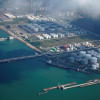Oil prices rise on Middle East conflict fears as Israel steps up attacks

Oil prices extended gains on Monday, buoyed by escalating concerns over potential supply pressures from Middle East producers following Israel's increased attacks on Iranian-backed forces in the region.
Brent crude futures for November delivery increased 51 cents, or 0.71 percent, to $72.49 a barrel as of 0330 GMT. That contract expires on Monday, and the more-active contract for December delivery gained 50 cents, or 0.7 percent, to $72.04.
US West Texas Intermediate crude futures added 43 cents, or 0.63 percent, to $68.61 a barrel.
Last week, Brent fell around 3 percent while WTI fell by around 5 percent as demand worries increased after fiscal stimulus from China, the world's second-biggest economy and top oil importer, failed to reassure market confidence.
However, prices on Monday were supported by the possibility of a widening Middle East conflict involving Iran, a key producer and member of the Organization of the Petroleum Exporting Countries (OPEC), after Israel stepped up its attacks on the Hezbollah and Houthi militant groups that Iran backs.
While excessive supplies are a key concern for oil markets, markets broadly fear an escalation in the Middle Eastern crisis that could dampen supplies from key producing regions, said Priyanka Sachdeva, senior market analyst at Phillip Nova.
Israel said it bombed Houthi targets in Yemen on Sunday, expanding its confrontation with Iran's allies two days after killing Hezbollah leader Sayyed Hassan Nasrallah in an escalating conflict in Lebanon.
US Defence Secretary Lloyd Austin has authorised the military to reinforce its presence in the Middle East, with the Pentagon saying on Sunday that should Iran, its partners, or its proxies target US personnel or interests, Washington "will take every necessary measure to defend our people".
In the context of Israel's decisive strike on Hezbollah, oil prices will continue to be driven by supply and demand dynamics, said Tony Sycamore, market analyst at IG.
Given the upcoming end of Opec+'s voluntary supply cuts on Dec. 1, WTI may test its 2021 lows in the $61 to $62 a barrel range, he said.
"Additionally, despite China's recent dovish shift, it's unclear if this will translate into higher fuel demand, considering China's advancements in electrifying and decarbonising its transportation sector," Sycamore added.
Later on Monday, markets will be waiting to hear from Federal Reserve Chair Jerome Powell for clues on the central bank's speed of monetary easing, and seven other Fed policymakers are due to speak this week, ANZ analysts said in a note.
Also due are data on job openings and private hiring, along with ISM surveys on manufacturing and services.
With the Fed and other major central banks embarking on policy easing, some economic recovery could just be around the corner, said Phillip Nova's Sachdeva.
"How well demand responds to easing rates, and how much Chinese demand revives after the major stimulus injected last week, will eventually shape oil market dynamics going forward," she said.

 For all latest news, follow The Daily Star's Google News channel.
For all latest news, follow The Daily Star's Google News channel. 








Comments